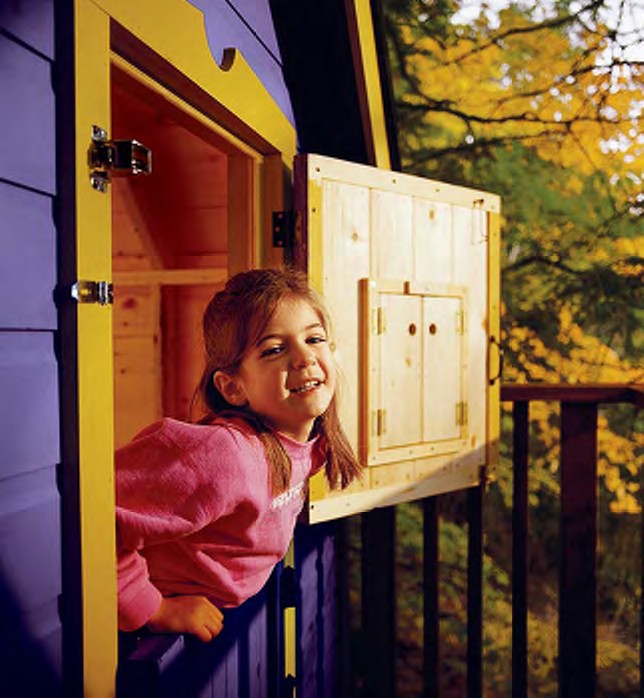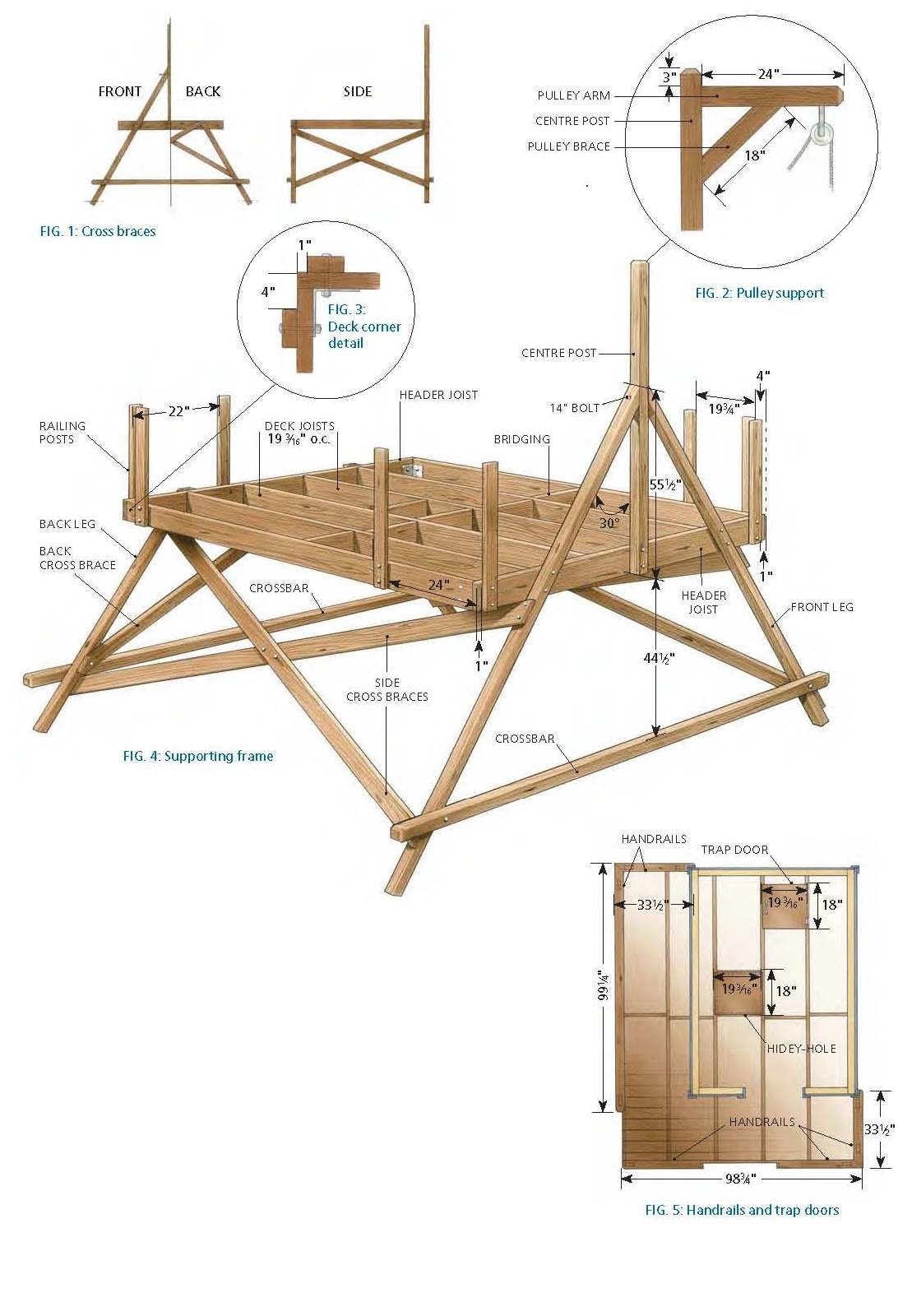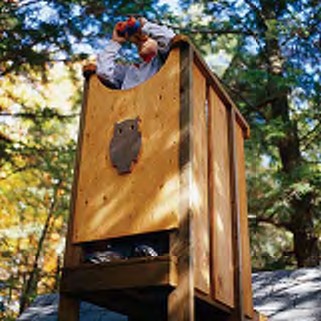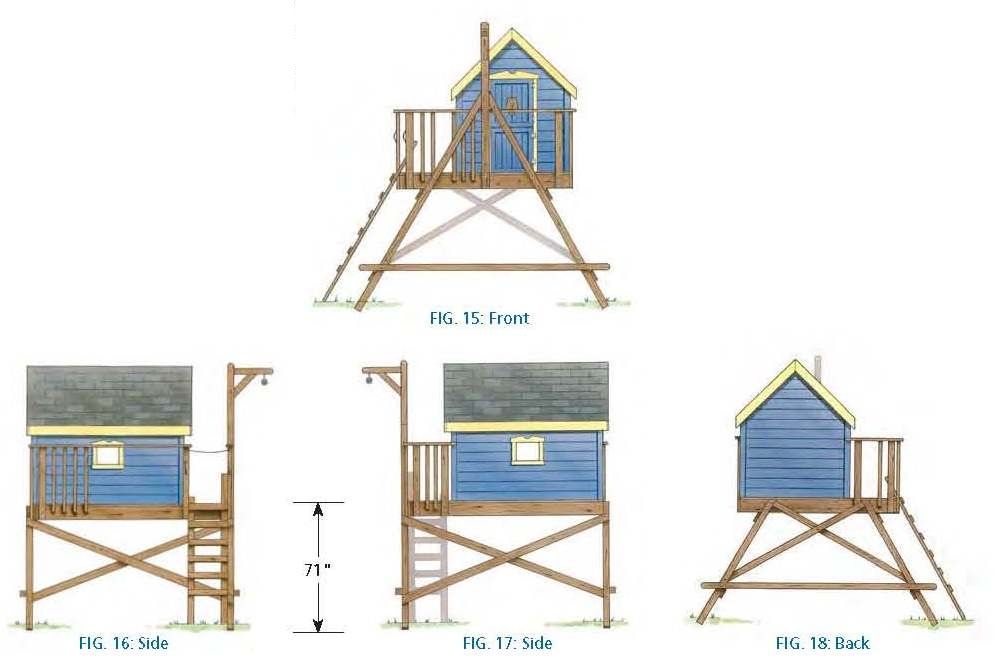|
Do your kids want to
live it up? Here’s how to get your tree house
project off the ground!
When I was kid, growing up in the wilds just outside
of North Bay, we always had a treehouse – rather
rickety affairs that we built ourselves. We spent
endless hours in them; it gave us a sense of
independence and adventure, elevated as we were
above the world (even if it was just a few meters
up).
Back then, we didn’t think our treehouses might
damage living trees and, like all children, we
didn’t worry much about our own safety. But I
designed this project with safety, stability, and
tree health in mind. The treehouse is freestanding,
so you can build it anywhere, even where there are
no suitable trees.
It’s supported by a triangular framework, a
versatile and inherently stable structure. In fact,
there’s no need to sink the posts into the ground; I
could have located the treehouse on top of good old
Canadian Shield granite.
If you’ve already built our
outhouse plans, you’ll recognize many of the
techniques here. This is a bigger project, but it’s
fun, especially if you get the kids involved in
planning and customizing it. And for me, there’s
nothing as rewarding as kudos from Douglas (pictured
playing chess), one of the treehouse’s satisfied
tenants along with his sister Leah, below. “Wow,
this is so cool,” he said as he inspected the
finished product. “This must be the best treehouse
on the lake.”
Materials
For a shopping list you can take to the
lumberyard, see the table on the right.
PT Pressure-treated spruce
UT Untreated spruce
SPS Spruce strapping
T&G #4 pine tongue-and-groove
Newer pressure-treated wood corrodes and
weakens some metals. Always use hardware
(hot-dipped galvanized or stainless steel)
intended for contact with it.
Support structure and deck
MATERIAL CUT TO
QTY.
Centre post 4 x 4 PT
8'
1
Front legs 4 x
4 PT
12'
2
Back legs
4 x 4 PT
8'
2
Leg crossbars 4 x 4 PT
12'
2
Header joists 2 x 8 PT
8'
2
Deck joists 2
x 8 PT
9'9"
6
Pulley arm 4 x 4 PT
24"
1
Pulley brace 4 x 4 PT
18"
1
Railing posts 2 x 4 PT
43"
8
Side cross braces 2 x 6 PT 12'
4
Back cross braces 2 x 4 PT 10'
2
Deck boards 5⁄4 x 6 PT
8'
25
Bridging
2 x 8 PT 1711⁄16
6
Ladder stringers 2 x 4 PT
8'
2
Ladder rungs 2 x 6 PT
2' x 23⁄4" 6
Handrails
2 x 4 PT
34"
2
2 x 4 PT
8'4"
2
Balusters
PT precut 42" 401⁄2"
40 |
Support-structure hardware
QTY.
#8 x 2" deck screws
31⁄2 lbs
#8 x 3" deck screws
4 lbs
Dock-style corner brackets
4
(Kwikdox model KD90-CN)
5⁄16" x 4" lag bolts
16
3⁄8" x 4" carriage bolts
30
3⁄8" x 6" carriage bolts
15
3⁄8" x 8" carriage bolts
4
1⁄2" x 14" carriage bolt
1
5⁄16" washers
16
3⁄8" washers and nuts
49
1⁄2" washers and nuts
1
2 x 8 joist hangers
8
Joist hanger nails
3⁄4 lb
51⁄2" zinc-plated door pulls 2
Clothesline reel
1
Safety snap
1
Threaded 3⁄8" hook
1
Small dock cleat
1
1⁄4" rope
25' |
Lumber
shopping list
With careful layout and cutting, this is
enough wood to build the treehouse.
SIZE LENGTH
QTY.
Pressure Treated
2 x 4
8'
6
Spruce
2 x 4
10'
2
2 x 4
12'
2
2 x 6
8'
1
2 x 6
12'
4
2 x 8
8'
2
2 x 8
10'
7
4 x 4
8'
2
4 x 4
12'
5
5⁄4 x 6
8'
25
Pressure Treated
2 x 2
42"
40
Precut balusters
Untreated Spruce
2 x 3
8'
25
2 x 4
10'
8
Spruce strapping
1 x 3
10'
4
Pine
1 x 2
8'
2
1 x 2
10'
1
1 x 3
8'
4
1 x 3
10'
2
1 x 4
10'
1
1 x 4
12'
1
1 x 6
8'
1
1 x 6
10'
5
Pine cove
1 x 6
300'
Pine tongue and
1 x 6
10'
2
groove
Pine door stop
12'
#4 roof boards
1 x 10 150'
1⁄4" G1S plywood
4' x 8'
1
1⁄4" G1S plywood
4' x 4'
1
1/2" spruce plywood
4' x 8'
1 |
House
MATERIAL CUT TO
QTY.
Side walls
Top and
2 x 3 UT
90"
4
bottom plates
Studs
2 x 3 UT
45"
12
Window sills
2 x 3 UT
161⁄2"
4
and headers
Temporary brace 1 x 3 SPS
8'
2
Back wall
Top and
2 x 3 UT
61"
2
bottom plates
Studs
2 x 3 UT 45"
3
Temporary brace 1 x
3 SPS 8'
1
Front wall
Bottom plates
2 x 3 UT
173⁄4"
2
Studs
2 x 3 UT
531⁄4"
2
Girts
2 x 3 UT 183⁄4"
4
Header
2 x 3 UT 62"*
1
Temporary brace 1 x
3 SPS 8'
1
Cladding
Siding
1 x 6 300'
pine cove
Corner trim
1 x 2 pine 48"
4
1 x 3 pine 54"
4
Flooring
1⁄4" G1S
11⁄2
plywood
pces
|
Roof
MATERIAL CUT TO
QTY.
Rafters
2 x 4 UT 57"
16
Ridge board
1 x 6 pine 8'4"
1
Back gable
2 x 3 UT 30"
1
studs
2 x 3 UT 16"
2
Front gable
2 x 3 UT 24"
1
stud
Roof boards
1 x 10 #4 pine
150'
Side fascia
1 x 6 pine 8'6"
2
End fascia
1 x 6 pine 58"
4
Collar ties
2 x 3 pine 32"
2
Window frames
Top and bottom 1 x 3
pine 161⁄2"
4
Sides
1 x 3 pine 121⁄2"
4
Window side trim 1 x 3
pine 121⁄2"
4
Window
1 x 4 pine 21"
2
bottom trim
Window top trim
1 x 6 pine 22"
2
Door frame
Side jambs
1 x 4 pine 54"
2
Head jamb
1 x 4 pine 251⁄2"
1
Door side trim
1 x 3 pine 54"
2
Door top trim
1 x 6 pine 31"
1
Door stop
pine trim 12'
Door
Outer frame rails
1 x 3 pine 181⁄2"
4
Outer frame stiles 1
x 3 pine 263⁄4"
4
Inner frame rails
1 x 2 pine 231⁄2"
4
Inner frame stiles
1 x 2 pine 233⁄4"
4
Door panel pieces 1
x 6 T&G 233⁄4" 8
Owl door rails
1 x 3 pine 123⁄8"x 1" 4
and stiles
Owl door panels
1 x 6 T&G 12" 2
|
Bunk beds
MATERIAL CUT TO
QTY.
Bases
1⁄2"
61" x
2
plywood
24"
Side ledgers
2 x 3 UT
253⁄4"
4
Back ledgers
2 x 3 UT
58"
2
Rails
1 x 4 pine 61"
2
Support strips
1 x 2 pine 61"
2
Ladder stringers 2 x 3 UT
4'
2
Ladder rungs
2 x 3 UT
12"
4
House hardware
QTY.
Shingles
3 bundles
7⁄ 8" roofing nails
3⁄4 lb
11⁄4" ring nails
3⁄4 lb
#8 x 11⁄4" wood screws
100
2" finishing nails
2 lbs
4" strap hinges
2
3" butt hinges
2
2" butt hinges
4
Spring hinges
2
21⁄2" barrel bolt
1
43⁄4" door pulls
3
Screen door catch
1
Foam weatherstripping
12'
Door sweep
1
Fibreglass screening
3' x 3'
Outdoor glue |
|
 |
The
Support Framework
1. The spreading triangular frames, front and back,
give the treehouse a large, stable footprint and
help prevent racking. Start with the front assembly,
bolting the centre post to the middle of one header
joist, using two 3⁄8" x 6" carriage bolts in
predrilled 3⁄8" holes. As you work, check regularly
that your assembly is square. Tip: Sight down
any structural pieces that aren’t vertical –
including crossbars, legs, joists, and rafters – and
look for any crown, or curve. Position pieces so the
hump of the curve points up; gravity will work to
straighten it out.
2] Cut one end of each front leg at a 30° angle, as
in Figure 4. Working flat on the ground, clamp the
legs to the header joist and, with a few 3" screws,
temporarily secure their angled ends to the centre
post. Chamfer the crossbar ends: Mark a line 1" from
the ends on all four sides, and with a circular saw
blade set to a 45° angle, bevel the edges. Lay the
crossbar on top of the legs. Clamp in place. Drill
3⁄8" holes where shown (six in all for the header
and crossbar) and secure with 6" and 8" bolts, just
finger-tight for now. Tip: Prevent scrapes
and barked shins by rounding off any sharp, pointy
ends. Cut bolt ends off and file smooth; soften
protruding wood corners by chamfering or rounding.
Strategically placed foam, such as camping pads and
foam pipe wrap, can also help avoid bumps and
bruises.
|
Free
Tree House Wood Plans
(Right Click on Image, and Select View as
Image or Save As to See the FULL SIZE
Picture)

 |
3] Drill
a 1⁄2" hole through the legs and centre post, near
the thickest part of this joint, for the 1⁄2" x 14"
bolt (substitute threaded rod if you can’t find a
long bolt). You’ll be drilling through about 12" of
wood, so you’ll need an extra-long bit or a bit
extender. Chisel a neat pocket at both ends of the
hole for the bolt head, washer, and nut. Tighten all
bolts and cut and file all exposed threaded ends.
4] Assemble the back frame. It mirrors the front
assembly, with three differences: There’s no centre
post, the legs don’t extend above the header joist,
and the back legs are stiffened with two diagonal
cross braces, which you’ll add later.
5] Cut the deck joists (six 9'9" joists).
6] Now let the fun begin! You’ll need a helper or
two for a few hours to get the frame assembly up,
level, plumb, square, and the correct height above
the ground. The deck surface cannot be higher than
71" above grade, or the railing must be 42" high
instead of 36" (according to the most local building
codes, you should check yours). To get the deck to
the right height, you’ll likely have to dig in, or
trim, one or more legs. Work carefully, because
you’ll have several heavy pieces propped up with
temporary braces. A fairly level site will make this
job easier. On the ground, mark a 12' x 10'8"
rectangle. This will show approximately where the
ends of the legs sit. Measure diagonals to check
your layout is square; if both diagonal
corner-to-corner measurements are the same, it’s
square.
7] You’ll need to determine which of the four leg
positions is lowest. You can do this with a long
straight board and a carpenter’s level, a line
level, or a water level.
8] Starting at this lowest leg, stand the
corresponding assembly up, in position, and brace it
so it is more or less plumb. Check that the header
joist is level and the right height from the ground
(71" less the thickness of the deck boards). If not,
trim or dig in the legs to suit.
|
 |
9] Once
that’s done, stand the other frame assembly up, in
position, and brace again for plumb. Place a
straight board from one header joist to the other,
check for level, then trim or dig in the second
assembly.
10] Screw two deck joists (with 3" deck screws)
between the front and back header joists, one at
each end. Double-check that everything is square,
plumb, level, and to the correct height. After a few
more adjustments, and perhaps a few expletives, the
basic supports will be in place.
11] Attach the diagonal side cross braces to the
legs to help strengthen and stabilize them (see
Figure 4). Clamp them in position to mark the
excess, remove and trim, and then tack back in place
with 3" screws. Drill two 5⁄16" holes through each
end of the braces and about 1" into each leg. Hammer
a 4" lag bolt, with washer, into each hole and
tighten. Drill two 3⁄8" holes where the braces
intersect and secure with 4" carriage bolts. Tip:
Newer pressure-treated wood, called Alkaline Copper
Quaternary (ACQ) and Copper Azole (CA), is more
corrosive to metal, so you must use hot-dipped
galvanized or stainless- teel hardware, or fasteners
recommended by the manufacturer, or the hardware
could fail prematurely. Check labels when you buy.
Electroplated or Grade 2 steel just won’t do.
Filling in the
deck
1] Now reinforce each deck corner
with a metal bracket, the kind commonly used in dock
building, bolted to the inside face (see Figure 3).
For extra strength, five of the railing posts are
bolted with the headers or joists through these
brackets. Making sure the posts are plumb, drill
3⁄8" holes and install with the 3⁄8" x 4" carriage
bolts.
2] Use joist hanger nails, not deck screws, to
attach joist hangers to the front and rear header
joists at 19-3⁄16" on centre (o.c.). Slide the deck
joists down into the hangers, screw through the
header joists into the deck joists with 3" deck
screws, and nail the hangers.
3] Cut the deck boards to 96". Temporarily screw one
across the middle of the deck framework to hold each
joist in place. Starting at the back, nail or screw
(with 2" hardware) the first deck board flush to the
edge. The next three boards need to be cut to leave
a space for the trap door (see Figure 5), which is
193⁄16" wide. Mark these cuts to line up with the
joist centers, so when the trap door is closed, both
sides will be supported. Likewise, cut the eighth,
ninth, and tenth boards to leave an opening for the
secret hidey-hole. Tip: For screws going into the
ends of the deck boards, drill clearance holes first
to prevent splitting.
4] When you reach halfway, remove the temporary
brace. At this point, cut the 2 x 8 bridging pieces
to fit between the joists; note that a piece of
bridging forms the front of the box for the
hidey-hole, and an extra bridging piece forms the
back. Screw pieces of 2 x 2 around the inside bottom
edges of the hidey-hole to make a ledge; then screw
down 1⁄2" plywood for the bottom. Secure the
remaining deck boards to the joists; you will likely
have to rip the last one to fit.
5] Attach the 2 x 4 cross braces to the back legs,
trimming off any excess length. Secure the braces
with 3⁄8" x 4" carriage bolts at their intersection,
at bottom through the legs, and at top through the
header joist. One brace has its end bolted through
the 2 x 4 railing post as well as the header joist,
requiring a 6" bolt.
Add the ladder and pulley
1] For the ladder rungs, I ripped pressure treated 2
x 6s in half to 2-3⁄4". Screw two rungs to the
stringers to square the ladder up. Position it at
the same angle as the legs, fitting between the two
railing posts (see Figures 15 and 16). Screw the
ladder stringers into the deck joist. Starting from
the top, screw the first rung to the stringers with
four 3" screws. Ensure its top edge is flush with
the deck surface to avoid a tripping hazard. Add the
other rungs 24" apart. You can adjust this distance
so the last rung is high enough to help keep very
young children off the structure. On the right side
of the ladder, screw through the railing post into
the stringer; on the left side, cut the stringer
flush with the railing post; again, this minimizes
the trip factor. Two door pulls, attached to the
railing posts, make climbing easier.
2] Cut the pieces for the optional pulley structure
and drill 5⁄16" holes for the bolts. Use two 5⁄16" x
8" lag bolts to secure the horizontal piece to the
centre post and four 5⁄16" x 4" lag bolts to attach
the support piece. Add a 3⁄8" threaded hook, a
clothesline pulley, about 25' of rope with a snap,
and a cleat to tie the rope off.
The
wee house
To give myself room to work on the deck, I installed
the handrails and balusters after I finished
building and shingling the house. For safety,
temporarily clamp some boards in place as railings,
and watch your step. The untreated 2 x 3 lumber that
frames the house is usually sold only in 8' lengths,
so it requires some careful layout work to minimize
waste.
1] On the ground, assemble the side wall framing as
shown in Figure 8. Temporarily attach a piece of 1 x
3 spruce strapping as a diagonal brace across the
inside of each wall to keep it square. Bring one
wall up and screw the bottom plate to the deck,
flush to the outside and back edges. If it’s windy,
you might have to brace it to the floor.
2] Assemble the back wall, which consists of a top
and bottom plate and three inside studs. You’ll note
there aren’t studs on the ends of this wall; the
front and back wall share corner studs with the
sides. Carry the back wall assembly up onto the deck
and screw the bottom plate to the deck, flush to the
back edge and tight to the bottom plate of the side
wall. Bring up the other side wall and screw it to
the deck, being careful to keep it parallel to the
other side wall. Toenail (or screw) the back wall
top plate to the top plates of the side walls.
Attach a temporary brace to the inside of the back
wall to keep the side walls plumb. Don’t worry about
any gable studs for now.
3] The front is assembled without the header or the
gable stud (both will be added once the rafters are
in place). Cut studs, girts, and bottom plates to
length, notching the outside ends of the horizontal
girts to wrap around the side-wall studs (see Figure
8). Screw the pieces together and carry both halves
of the wall up onto the deck and screw in place. Add
braces to the inside so that the two front
studs are plumb and aligned, and the wall is stable.
4] I selected 1 x 6 pine cove siding for the walls.
Start at the bottom of the back wall and work up
until you are one piece short of the top plates (use
2" finishing nails).
5] Proceed in the same manner with the side walls,
leaving openings for the windows. The last course of
siding on each side is notched to accept the rafters
(see Figure 9). Tack this course in place to mark
the notches; their sides line up with the side-wall
studs and the bottoms align with the top plates.
Remove, cut, and tack them up again, since you’ll
need to rip them to match the height of the rafters.
6] Cut the rafters as in Figure 7; 12 have bird’s
mouth notches while four, for the gable ends, don’t.
These notches include extra width so they fit over
the siding. This unusual detail makes it easier to
nestle the siding in tight to the roof and keep out
bugs. Position one of the rafters in a siding notch.
Mark the siding at the top edge of the rafters,
remove and rip the last course of siding. With this
cut, the roof boards will seal snugly with the
siding. Nail this last course of siding in place.
7] Lay out the locations for the rafters on the
ridge board. Position each rafter in a notch cut in
the siding and over a sidewall stud; secure each
with a 3" screw through the narrowest part of the
bird’s mouth, into the top plate. Slide the ridge
board up between the rafters; position the rafters
on one side and screw or nail in from the opposite
side (naturally, you’ll have to shift one set of
rafters out of the way). Move the remaining rafters
into place and toenail from the opposite side. Check
that the rafters are plumb and attach a brace across
one side of the roof to stabilize it. Finish
fastening the rafters to the top plate with two
additional screws for each rafter.
8] Add 2 x 3 studs to fill in the gable end of the
back wall as in Figure 8. To avoid complex notching
to fit them around the rafters, I turned the two
short studs 90° so they’re flush with the back of
the building. Finish siding the back wall.
9] Notch the front wall header to fit around the
rafters. Screw it to both the door frame studs and
to the rafters. Add the gable stud and finish siding
the front. Remove all the braces.
10] Beginning at the roof ’s leading edge, nail or
screw 1 x 10 rough-sawn pine boards to the rafters.
The roof is 8'6" long, so lay the boards out
carefully to minimize waste. You’ll have to rip the
top course on each side to butt over the ridge.
11] Screw the remaining four rafters, the ones with
no bird’s mouth, to the ends of the roof boards and
to the ridge board. 12] Cut the side fascia boards
and nail to the rafter tails. Cut the four end
fascia pieces at 45° and temporarily nail in place;
mark where the side fascia meets the end fascia.
Remove the end fascia and cut to length, at the same
time trimming the sharp bottom corner flush with the
side fascia. To avoid scraped scalps when kids are
tearing around the corner of the deck, round off
that corner of the fascia.
13] Shingle the roof. I didn’t use metal eave
starter because I was concerned that the sharp edges
might prove to be a hazard. I also used 7⁄8" roofing
nails because they don’t stick through the roof
boards. Remember to round the corner of the shingle
near the ladder.
14] The door jamb is 1 x 4 pine – nail the pieces to
the door studs and header, shimming if necessary so
the jamb is plumb and level. The door trim is 1 x 3,
except for the piece above the door, which is
fashioned out of a piece of 1 x 6.
15] Install window frames as you did the door jambs,
although it’s not critical that they’re plumb and
level. Staple screens to the frames and add trim.
16] Add corner trim to the house (1 x 3s on the
front and back; 1 x 2s on the sides).
|
Free
Tree House Wood Plans
(Right Click on Image, and Select View as
Image or Save As to See the FULL SIZE
Picture)



|
|











